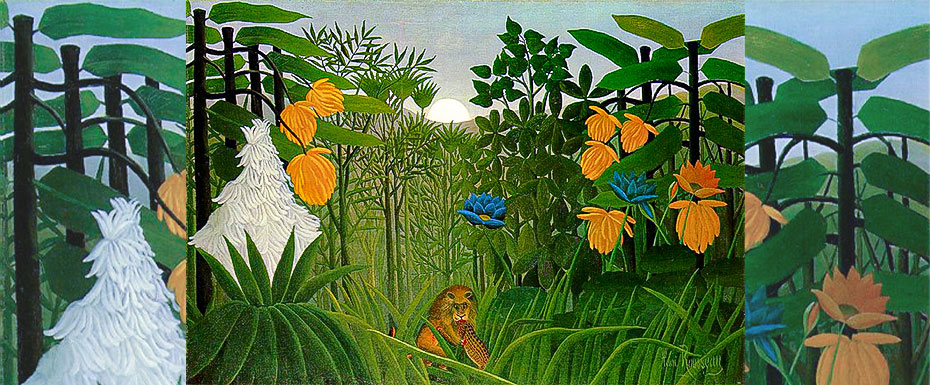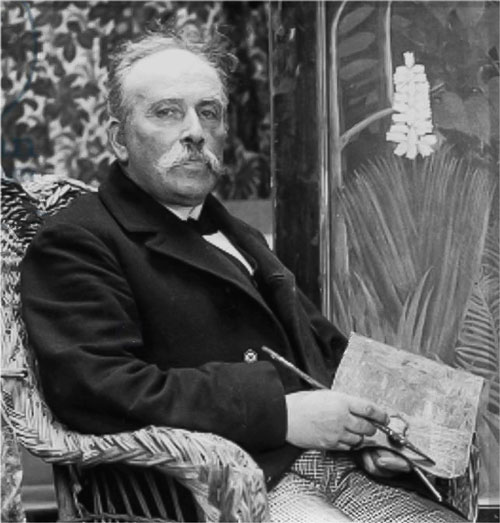
Henri Rousseau was a French self-taught artist and a dreamer who took up painting seriously only at the age of 40. Having no professional training and connections, he managed to attract the attention of the Parisian avant-garde. He took his rightful place among such prominent artists as Pablo Picasso, Henri Matisse, and Paul Gauguin, becoming a key figure in the history of naive art. Some regard Rousseau with contempt and derision, while others recognize him as a primitivist genius. To this day, his works are controversial among art critics, and his imaginary jungles are striking in their grandeur.
Early Years
Henri Rousseau was born on May 21, 1844, in the small French town of Laval. His father was a hereditary tinsmith, and his mother was the daughter of an officer of Napoleon’s Great Army. By the time Henri was 8 years old, his parents had gone bankrupt and lost their home, so little Rousseau had to go to a boarding school. It was there that he fell in love with drawing.
After graduating from school in 1861, 17-year-old Henri moved with his family to Angers, where he found a job as an assistant bailiff in a law office. However, his career did not last long due to a scandalous incident. In 1863, Rousseau was accused of petty theft, and in order to avoid imprisonment, he agreed to 7 years of military service. He met soldiers who survived the French expedition to Mexico (1862-1865) in support of Emperor Maximilian I. Rousseau eagerly listened to their memories of the delights of this subtropical country. In the future, these stories had a great influence on his style of depicting the jungle, and the realism of the paintings caused rumors that the artist was painting from his memory of those places. It is noteworthy that Rousseau himself never left France, although he did not refute popular legends about his travels.
Personal Life and Career
Henri Rousseau moved to Paris to take care of his mother after his father died in 1868. The artist fell in love with the daughter of his landlady, Clémence Boitard, and married her a year later. On weekends, the couple took walks in the parks of Paris, where Rousseau often painted portraits of his wife.

While working at the customs office, Rousseau often practiced his artistic skills. He progressed as an artist, copying works from art galleries in Paris and sketching in the city’s botanical gardens and historical museums. Since Henri did not internalize academic dogmas, he managed to develop his style. His portraits and landscapes looked childishly naive. With the same naivete, Rousseau perceived sarcasm and teasing from others as sincere praise.
First Exhibition
In 1886, at the age of 42, Rousseau applied to participate in an exhibition where any artist could share their work. Henri presented Carnival Evening, a canvas depicting a young couple in carnival costumes walking through a field on a winter night.
The unprepared audience perceived the artist’s debut with contempt and ridicule: he was scolded for his childish style, accused of incorrect perspective and composition. Despite the attacks from the Parisian bohemians, Rousseau’s work found a response among some Impressionists. Camille Pissarro noted that Carnival Evening contains special undertones emphasizing shadowplay.
Primitivism and Folk Art
Henri Rousseau went down in history as one of the most famous representatives of primitive art. Often, primitivists were professional artists who deliberately deviated from academic dogmas for the sake of new, more sincere art. The artists who do not have any formal education also fall into this category.
Henri Rousseau wrote explanatory poems for his works. They were often called Rousseau’s Drawn Poems. These works refer to the tradition of the French folk art. Like the inscriptions on peasant works, Henri’s words gave additional meaning to the canvases.
Jungle Rousseau
Rousseau’s jungle works are often referred to as Botanical Eden. Its lotus-like flowers and incredible foliage look amazingly lively and abstract at the same time. His paintings often seem to combine multiple perspectives. It doesn’t matter who inhabits the jungle: whether it’s a lion knocking down an antelope or a gorilla pouncing on an Indian – the jungle is always calm on Henri’s canvases. Rousseau had his unorthodox vision of nature, but he didn’t only rely on his imagination. To draw animals more accurately, the artist spent a lot of time in zoos and natural history exhibitions in Paris.
Rousseau’s Reputation

Getting to know Alfred Jarry allowed Rousseau to establish connections in the literary and artistic avant-garde of Paris, including Pablo Picasso and Max Jacob. They later became sincere admirers of his work. Picasso was convinced that it was Henri’s naivete that allowed him to reveal the essence of man and go beyond the classical depiction of nature.
Unfortunately, the persistence and artistic vision of Henri Rousseau did not captivate the public over time. He was the subject of ridicule; people refused to accept him and recognize him as an artist and master of primitivism. This did not bother Rousseau at all: he tended to take things lightly and often simply let all the negativity slip past him. At some point, he even managed to find his way into a bohemian society: Henri arranged “Evenings with the Customs Officer,” where he showed his paintings to young people and entertained the guests with music.
Death and Legacy
Henri Rousseau died on September 2, 1910, after a long battle with gangrene. However, even after the artist’s death, his works continued to inspire other artists, including Pablo Picasso, Fernand Léger, Max Ernst, and many others.
The paintings of the great primitivist are exhibited in the most prestigious museums around the world – the Museum of Modern Art in New York, the National Gallery of Painting in Washington, the Philadelphia Museum of Art, the Hermitage in St. Petersburg.
Rousseau’s attitude to art can be summarized with the following quote: “Nothing makes me happier than contemplating and portraying nature. Would you believe me if I said that when I go out of town and see this sun, this greenery, and these flowers, I sometimes say to myself: “All this belongs to me, it really does!”





